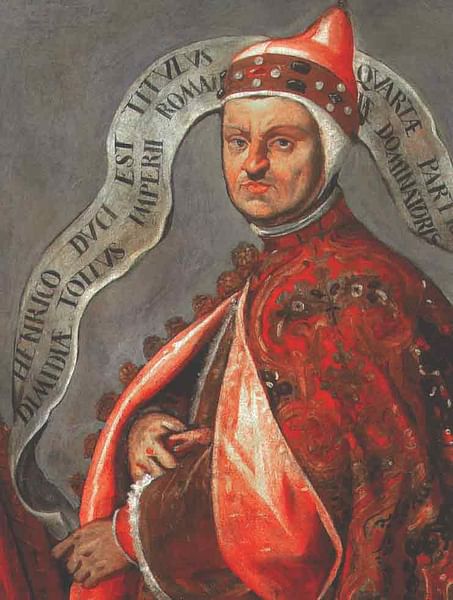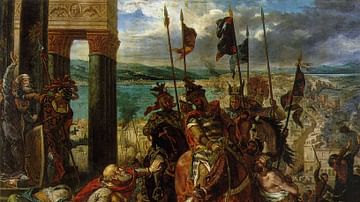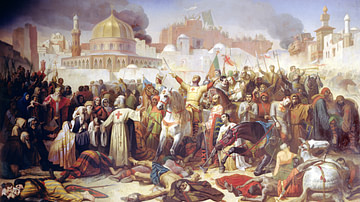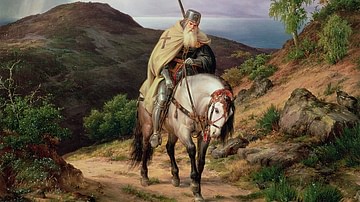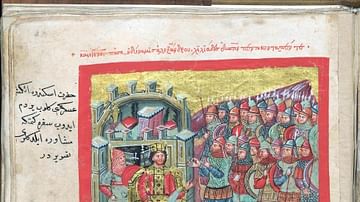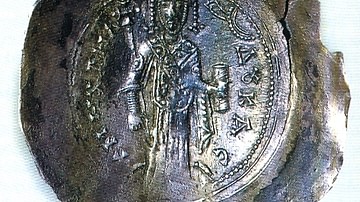In 1204 CE the unthinkable happened and Constantinople, after nine centuries of withstanding all comers, was brutally sacked. Even more startling was the fact that the perpetrators were not any of the traditional enemies of the Byzantine Empire: the armies of Islam, the Bulgars, Hungarians, or Serbs, but the western Christian army of the Fourth Crusade. Finally, the mutual suspicion and distrust that had existed for centuries between the western and eastern states and churches had blown up into full-scale warfare. With the fall of the city, many of its religious icons, relics, and artworks were spirited away and the Byzantine Empire was divided up between Venice and its allies. The empire would rise again from the ashes but never again could Constantinople claim to be the greatest, richest, and most artistically vibrant city in the world.
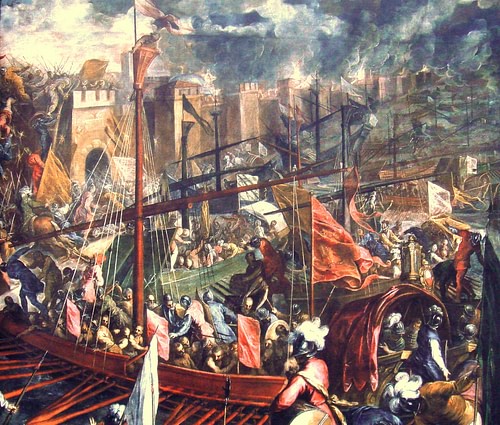
Prologue
The Byzantines, with their capital at Constantinople founded by Roman emperor Constantine I in 324 CE, saw themselves as the defenders of Christendom, the beacon which shone out across the Mediterranean and central Asia, hosts to the holiest city outside Jerusalem, and the rock which stood against the tide of Islam sweeping in from the east. For the western half of the old Roman Empire, though, the Byzantines were regarded as decadent, shifty, and untrustworthy, their religious practices were suspect, and several of their emperors had even proclaimed icons and their veneration as heresy.
The centuries of argument and mistrust, the constant rivalry between Popes and emperors, and the rising ambition of western states to wrest from Byzantium the remnants of its empire in Italy were, for a time, held in check by the first three Crusades. All three, though, would prove to be unsuccessful in permanently securing Christianity's Holy Places from the Arabs. Worse, they created a damaging rift in east-west relations as blame was apportioned to either side for the lack of success. The Byzantines were considered to lack the will to fight the common enemy while, from the other side, the Crusaders were seen as opportunists out to grab the choicest parts of the Byzantine Empire in the east. In a sense, both sides were right in their judgement.
The Byzantines had never fully understood the concept of a Holy War, which the western leaders used to rouse armies to be sent to the east. The west considered Byzantine emperors to be only ever interested in the preservation of their empire and perceived superiority over the west. For the emperors, though, they saw the Byzantine Empire and Christendom as one and the same thing, nor could they be criticised for thinking the Crusaders as an unruly mob of miscreants out on a looting party, given the rape and pillaging which often went on as Crusader armies passed through Byzantine territory. These were the experiences and suspicions on both sides leading into the early 13th century CE.
The Fourth Crusade
The Fourth Crusade was launched by Pope Innocent III (r. 1198-1216 CE) in 1202 CE with the principal intention of reclaiming Jerusalem for Christendom after its fall in 1187 CE to Saladin, Sultan of Egypt (r. 1169-1193 CE). In June 1202 CE the Crusaders assembled in Venice from across Europe, led by Marquis Boniface of Montferrat. From there they sailed to Egypt - seen as the soft underbelly of the enemy - or at least, that was the original plan. The Venetians, being the rapacious traders they were, insisted that their 240 ships be paid for, but the Crusaders could not meet the asking price of 85,000 silver marks. Consequently, a deal was made that in return for passage the Crusaders would stop off at Zara on the Dalmatian coast and reconquer it for the Italians, the city having recently defected to the Hungarians. The Venetians would also provide 50 ships at their own cost and receive half of any territory conquered.
The Pope was not best pleased to hear the news that Christian Zara had been sacked in November 1202 CE, and he promptly excommunicated the Crusaders and the Venetians. The ban was later lifted for the former, otherwise, they would not have been much use as Crusaders, one supposes.
Historians continue to debate the exact reason why the Crusaders then turned on Constantinople instead of Jerusalem, but one crucial ingredient in the troublesome mix of mutual suspicions between the western powers and Byzantium was the Republic of Venice and one man, in particular, the Doge Enrico Dandolo (r. 1192-1205 CE). Intent on winning Venetian domination of the trade in the east, he well remembered his undignified expulsion from Constantinople when he served as an ambassador. This seemed as good an opportunity as ever to finally knock out Constantinople as a trade competitor. In addition, the Pope would achieve the supremacy of the western Church once and for all and the Crusader knights would not only gain revenge on the duplicitous Byzantines for their unhelpful support of previous Crusades but also surely pick up some glory and handsome booty in the process. The riches of Constantinople could then pay for the rest of the Crusade as it marched on to Jerusalem. It may not have been so cynically planned by all parties but, in the end, it is exactly what happened with the exception that the Fourth Crusade ended with the fall of the Byzantine capital and Jerusalem was left for a later date.
The Attack on Constantinople
The Crusaders arrived outside Constantinople on 24 June 1203 and played their trump card. The western powers had agreed to back Alexios IV Angelos, the son of the deposed Byzantine emperor Isaac Angelos II (r. 1185-1195 CE) and promised to return his father (then imprisoned in Constantinople) to the throne if he promised to help the Crusaders with money, soldiers, and supplies. One Crusader was especially keen on the plan - Philip of Swabia, king of Germany (r. 1198-1208 CE), whose wife Irene was the sister of Alexios IV. With such credentials as a western pawn in Byzantine politics, Isaac was duly reinstalled in the palace of his ancestors in 1203 CE with Alexios as co-emperor.
Constantinople had fallen remarkably easily once the Crusaders had overcome the garrison at Galata and lowered the massive chain which blocked the harbour of the Golden Horn. Sailing in with their fleet and attacking the sea walls and land walls simultaneously with siege engines and scaling ladders, even the elite Varangian Guard could not prevent the attackers forcing their way into the city. The incumbent emperor and brother of Isaac, Alexios III Angelos, caught completely unprepared by the arrival of the Crusaders, fled the city.
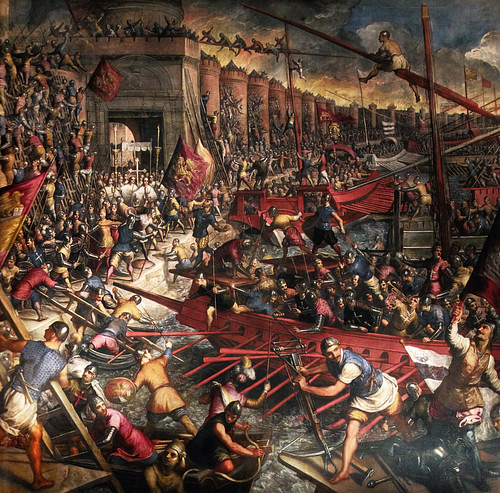
The old regime had fallen. However, the new pair of emperors went back on the arranged deal of assistance - although they had few resources to call on in reality - and also failed to formally make the Byzantine Church subordinate to the Pope. Alexios IV may not have helped the westerners very much but his people did not trust him anyway, given the way he ascended the throne and the presence of the Crusader army still outside the walls of Constantinople. The emperor's efforts to raise taxes and a massive fire in the city caused by the Crusaders setting a mosque ablaze only added fuel to the people's discontent. It was no surprise, then, that a usurper came along, one Alexios V Doukas. An army commander and senior diplomat backed by the people, Doukas seized the throne and executed his predecessors, father and son together, in January 1204 CE.
Alexios Doukas, known as Mourtzouphlos or "Bushy-Browed" attempted to put up a serious defence of his capital against unfavourable odds. For now Doge Dandolo and the Crusaders saw their golden opportunity not just to receive aid from the Byzantines but to loot the city entirely for all it was worth. Alexios ensured that the mighty Theodosian Walls were further strengthened, towers were heightened, and the initiative seized with several raids made on the Crusader camps. The Crusaders retaliated by launching an all-out attack on the morning of 9 April 1204 CE, but the Byzantines repelled it. Then, on 12 April, the Crusaders attacked the weaker sea walls of the harbour and targeted two towers in particular by lashing their ships together and ramming them repeatedly. Initially, the defenders held on, but eventually, the attackers forced their way through on both the sea side and the land side when the Franks finally battered down one of the city gates. The Crusaders were into the city and carnage followed. Citizens were raped and massacred, buildings were torched and churches desecrated. Alexios fled to Thrace, and three days of looting followed.
Looting the City
Robert de Clari, a lesser knight of the Crusader army, wrote an interesting account of the Crusade with invaluable descriptions of Constantinople's monuments and religious relics. Another record, this time by an author closer to the leadership, was compiled by Geoffrey de Villehardouin, the Marshal of Champagne. Villehardouin wrote his Conquest of Constantinople almost as a defence of the Crusaders' actions, and so the work is heavily biased, portraying the Byzantines as a shifty lot who only got their comeuppance. Finally, the Byzantine historian Niketas Choniates gives a vivid eyewitness account of the destruction and looting of the city in his Historia.
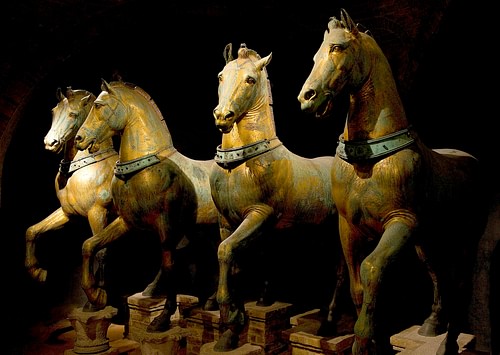
Constantinople, in 1204 CE, had a population of around 300,000, dwarfing the 80,000 in Venice, western Europe's largest city at the time. But it was not only its size that impressed the Crusaders, its buildings, churches and palaces, the huge forums and gardens, and, above all, its riches struck awe in the western visitors. Then awe was swiftly replaced by greed. Monumental sculptures, countless artworks, books, manuscripts, and jewels which had been steadily accumulated by emperors and nobles over a millennium were all stripped away and either destroyed or melted down for coinage. Furniture, doors, and marble architectural elements were taken away for reuse elsewhere, and even the tombs of emperors, including that of the great Justinian I, were opened up and their precious contents removed.
One of the most precious of all Byzantine religious relics to be stolen was the Mandylion shroud, a cloth or scarf said to have carried an impression of Christ himself. It was taken as a prize to France but, alas, this priceless icon was destroyed during the French Revolution. In another example, a gold reliquary containing a fragment of the True Cross ended up in the cathedral of Limburg in Germany. The Hippodrome of Constantinople, especially, was looted for all the treasures which stood in the central island around which the chariots raced. The four bronze horses now in St. Mark's Cathedral in Venice were probably once part of a chariot group which stood atop the arena's monumental entrance gate.
The Byzantines lamented not only the awful bloodshed and the monetary loss of the sacking but also the destruction of historically important artworks which they knew full well connected the city and, indeed, the western world back to its Roman heritage. The world had lost something great and undefinable, as powerfully summarised here by the historian J. J. Norwich:
By the sack of Constantinople, Western civilization suffered a loss greater than the burning of the library of Alexandria in the fourth century or the sack of Rome in the fifth - perhaps the most catastrophic single loss in all history. (306)
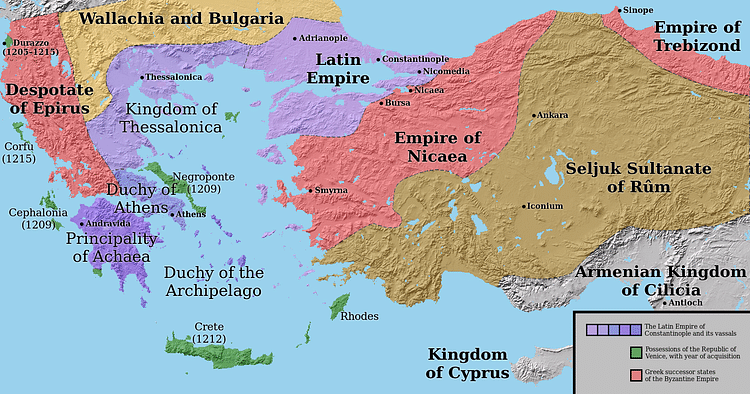
Aftermath
The emperor Alexios V Doukas fled the city, but he was later captured, blinded, and then tossed to his death from the top of a column a few months later. After the dust settled and everyone had their fill of pillaging and looting, the Partitio Romaniae treaty, already decided on beforehand, carved up the Byzantine Empire amongst Venice and its allies. The Venetians took three-eighths of Constantinople, the Ionian islands, Crete, Euboea, Andros, Naxos, and a few strategic points along the coast of the Sea of Marmara. Baldwin of Flanders was then made the Latin emperor (r. 1204-1205 CE) and crowned in the Hagia Sophia, receiving five-eighths of Constantinople and one-quarter of the empire which included Thrace, northwest Asia Minor, and several Aegean islands (notably Chios, Lesbos, and Samos). Boniface of Montferrat took over Thessalonica and formed a new kingdom there which also included Athens and Macedonia. In 1205 CE, following the death of Baldwin in a Bulgarian prison, William I Champlitte and Geoffrey I Villehardouin (nephew of the historian of the same name) founded a Latin principality in the Peloponnese while the French duke Othon de la Roche grabbed Attica and Boeotia.
The Byzantine Empire would be re-established in 1261 CE, albeit a shadow of its former self, when forces from the Empire of Nicaea, the centre of the Byzantines-in-exile (1208-1261 CE) retook Constantinople. Emperor Michael VIII (r. 1259-1282 CE) was then able to place his throne back in the palace of his Byzantine predecessors.
